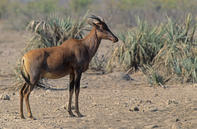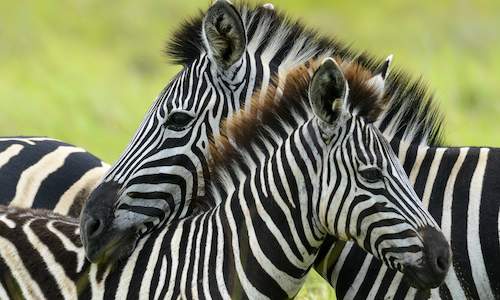
Name
Tsessebe (Damaliscus lunatus)Order
ArtiodactylaFamily
BovidaeAppearance
The tsessebe measures about 170 cm in length and 1.2 m at the shoulder, with bulls weighing approximately 140 kg and females 126 kg. Both sexes carry horns of 35 cm in length, the bulls’ being heavier than the cows’. The horns form a half-moon shape from the front. The tsessebe is reddish-brown in colour on the upper body and withers and has a dark face with purplish splotches on the shoulders. Tsessebe can run at a speed of 60 km/h.Tsessebe Diet
This animal is a grazer and feeds on a variety of grasses, choosing to eat the leaf rather than the stem. They are attracted to burnt areas for its fresh growth.Tsessebe Breeding
After a gestation period of seven months, a single calf is born weighing 11 kg. Being seasonal breeders, births occur during the months of September and October in South Africa. The rut takes place from mid-February to March, a time during which bulls perform displays as a part of the tsessebe mating ritual.Tsessebe Behaviour
Tsessebe are gregarious animals, living in small breeding groups of 6-10 cows and their young. Such breeding groups are not limited to a certain territory. Groups of territorial bulls and bachelor bulls can have up to 30 members. Groups of such size can be found close to water or good grazing. At the age of a year, young bulls are expelled from the herds to form bachelor groups.
In areas where a great number of tsessebe are found bulls engage in the "lek" territory system, which involves two or more males performing displays of courtship and the female choosing a partner with which to mate. Territorial males guard their areas of land by walking at a steady pace and defecating regularly.
Bulls and cows mark their territory by means of their preorbital glands, dropping their knees and rubbing their faces on a sandy patch or termite mound. This occurs particularly after the rain, although males mark territory more actively than females.
 Learning about the mammals of South Africa is now so much easier for all South Africans - SouthAfrica.co.za is an excellent source of inform...
Learning about the mammals of South Africa is now so much easier for all South Africans - SouthAfrica.co.za is an excellent source of inform...